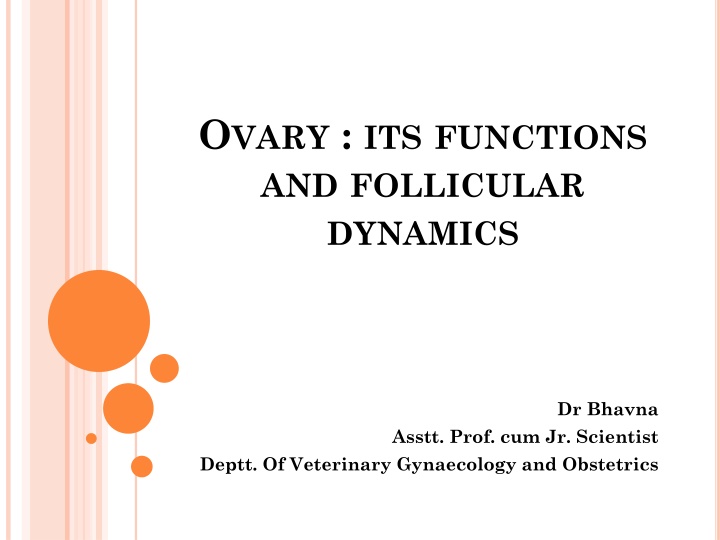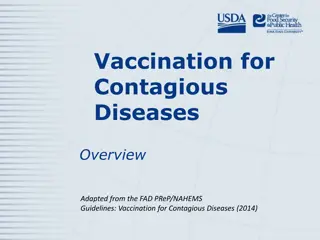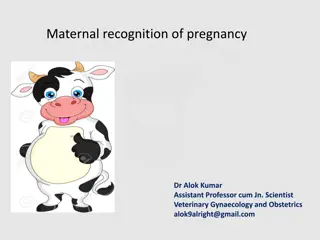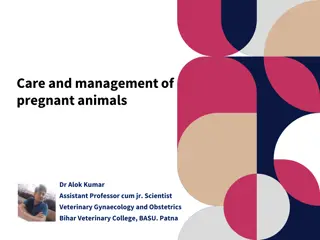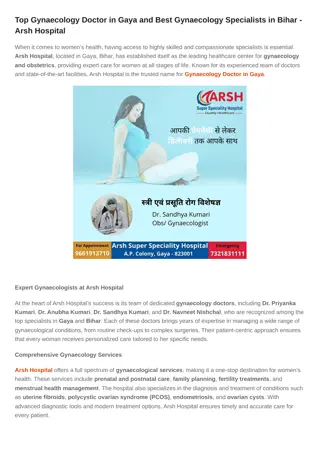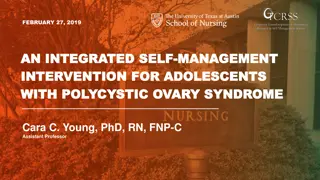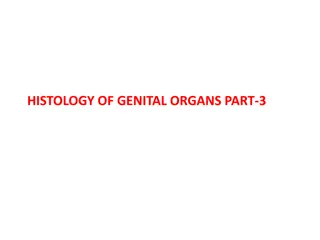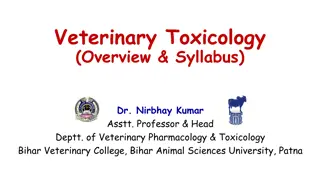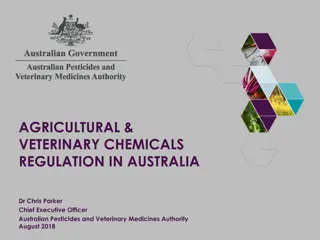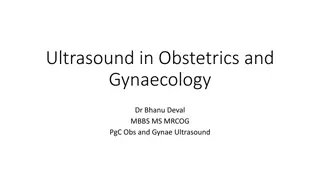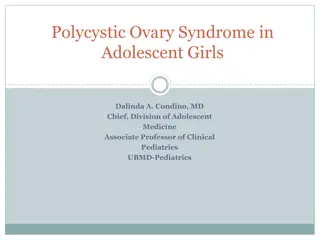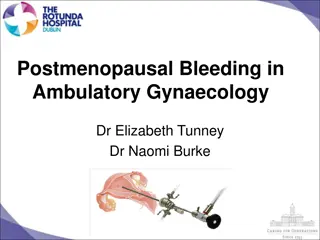Ovary Functions and Follicular Dynamics in Veterinary Gynaecology
Ovaries in animals have exocrine and endocrine functions, with follicular cells surrounding oocytes in primordial follicles. The mammalian ovary's epithelium, follicle development stages, and follicular dynamics are crucial in reproductive health.
Download Presentation

Please find below an Image/Link to download the presentation.
The content on the website is provided AS IS for your information and personal use only. It may not be sold, licensed, or shared on other websites without obtaining consent from the author.If you encounter any issues during the download, it is possible that the publisher has removed the file from their server.
You are allowed to download the files provided on this website for personal or commercial use, subject to the condition that they are used lawfully. All files are the property of their respective owners.
The content on the website is provided AS IS for your information and personal use only. It may not be sold, licensed, or shared on other websites without obtaining consent from the author.
E N D
Presentation Transcript
OVARY : ITS FUNCTIONS AND FOLLICULAR DYNAMICS Dr Bhavna Asstt. Prof. cum Jr. Scientist Deptt. Of Veterinary Gynaecology and Obstetrics
Ovaries lie in the abdominal cavity. Paired organs Has both exocrine (ovum release) and endocrine (steroidogenesis) functions. At birth, a layer of follicular cells surrounds the primary oocytes in the ovary to form primordial follicles. Shape and size of ovary varies with both species and stage of estrous cycle.
Epithelium covering the mammalian ovary is a single layer of cuboidal or low columnar cells called the germinal epithelium. This layer covers the entire ovary except in mare, where it is limited to ovulation fossa. Below germinal epithelium layer is tunica albuginia and then large mass of follicles.
FOLLICLES 1. Primodial / Primary follicles 2. Secondary / Growing follicles 3. Tertiary / Vesicular follicles 4. Graafian / Preovulatory follicles 5. Atretic follicles
PRIMARY / PRIMODIAL FOLLICLES It consists of an oocyte surrounded by a single layer of cuboidal granulosa (epithelial) cells, but no thecal layers. At this stage, cow oocyte is 20 to 30 in diameter. Ovary of a new born heifer may contain 1,50,000 follicles, which decreases to as few as 100 in cow of 15- 20 years of age. Only a few develop beyond this stage, as this is referred as resting stage and it may remain as such for few years without any growth.
GROWING / SECONDARY FOLLICLES Follicles that primordial follicles and have started growing, but have not developed thecal layer or antrum. have left the resting stage as The epithelium shows mitotic activities and is growing. Zona pellucida becomes more distinct. The number of these follicles is relatively few, but by the onset of puberty as many as 2000 growing follicles are present in an individual bovine ovary. Growing follicles are characterized by having two or more layers of follicle cells but without fully formed vesicle.
TERTIARY / VESICULAR FOLLICLES Pituitary gonadotropins (FSH and LH) Liquor folliculi from granulosa cells Accumulation in the intercellular spaces Dissociation of granulosa cells Formation of large, fluid-filled cavity (Antrum)
Zona pellucida is surrounded by a solid mass of radiating follicular cells, forming the corona radiata. At this stage both functions of ovary i.e. steriodogenic and gametogenic are developing. Growing/secondary follicles protrude from the surface of the ovary like a blister and is termed as mature follicle. There is formation of two cell layers theca interna and theca externa.
GRAAFIAN FOLLICLE Follicular cells increase in size. Oocyte pressed to one side, surrounded by accumulation (cumulus oophorus). of follicular cells In the follicular cavity, an epithelium of fairly uniform thickness membrana granulosa is formed. called the
PREOVULATORY FOLLICLE Blister like structure protruding from ovarian surface due to rapid accumulation of follicular fluid / thinning of the granulosa layer. Oocyte, in prophase of meiosis, resumes several hours before ovulation. First meiotic (maturational) division associated with extrusion of first polar body.
ATRETIC FOLLICLES Result from follicles that do not ovulate. Also referred as degenerating or anovular follicles.
FOLLICULAR FLUID Originates mainly from the peripheral plasma by transudation across the follicle basement lamina and accumulates in the antrum. Contains steroids and glycoproteins, synthesized by cell wall of the follicle, amino acids, enzymes, carbohydrates, salts, prostaglandins and most of them are in similar concentration as to blood serum. trace minerals, In large antral follicles, the follicular fluid contains remarkably high levels of estradiol 17 in follicular phase. However, polycystic ovaries contain high level of androstenedione.
FUNCTIONS OF FOLLICULAR FLUID Follicular fluid performs several functions like: 1. Regulation of granulosa cells function, initiation of follicular steriodogenesis. 2. Oocyte maturation, ovulation and egg transport to the oviduct. 3. Prepares follicles for formation of corpus luteum. 4. The stimulatory and inhibitory factors in the fluid regulates follicular cycle. growth and
CORPUS LUTEUM The growth of luteal cells is one of the fastest events known in biology, with in 3 to 4 days the blood clot is invaded by the new luteal cells so that the blood filled cavity looses it dark coloration. CL is one of the most vascularized organ of body. Corpus luteum develops after the collapse of the follicle at ovulation.
Inner wall of follicle develops into macro and microscopic folds that penetrate the central cavity. These folds consist of central core of stromal frame and large blood vessels, which becomes distended cells develops a few days before ovulation. They regress quickly and with infew hours after ovulation all remaining thecal cells are in advanced stage of degeneration. Hypertrophy and luteinization of granulosa cells begins after ovulation.
Luteal tissue enlarges mainly through hypertrophy of lutein cells. Progesterone is secreted by the lute in cells as granules. Generally the period of growth of C.L. is slightly longer than half of the estrous cycle. In cow, the weight and progesterone content of CL increases rapidly between day 3 and 12 of the cycle and remains relatively constant till day 16, when regression begins, if fertilization does not takes place.
CORPUS ALBICANS If fertilization does not occur, the CL regresses, allowing ovarian follicle to mature. other layer of As decreases in size, becomes white or pale brown, known as corpus albicans. these cells degenerate, the whole organ The reminants regress after 14 -15 days of estrus and reduced to half size in 36 hours but persist as a scar like structure for several successive cycles.
LUTEOLYSIS A substance luteolysin, produced by the uterus in absence of pregnancy causes regression of corpus luteum, this luteolysin may be Prostaglandin. Some scientists (Pharirs and Wyngarden) proposed that PGF2 , may cause luteolysis by constricting the utero-ovarian vessels and causing ischemia and starvation of the luteal cells.
Another group of Scientists proposed that PGF2 may act by: 1. Interfering directly with progesterone synthesis. 2. Competing with LH receptor site. 3. Destroying LH receptor sites. McCracken proposed that utero-ovarian transfer of PG could be due to countercurrent mechanism atleast in ewes as the ovarian artery follows a tortuous closely adhered path along utero-ovarian vein.
Abortions induction of labour during late pregnancy have been demonstrated using PGF2 in most of the domestic species. during early pregnancy and Abortion during early pregnancy is probably due to luteolysis as production falls sharply. the progesterone However, pregnancy depends upon action of PG on myometrium in addition to its effect on CL. induction of labor in late
ENDOCRINOLOGY OF FOLLICULAR GROWTH Growth, maturation, ovulation and leutinization of Graafian follicle depends pattern of secretion, sufficient concentration and adequate ratio of FSH and LH. upon appropriate FSH stimulating granulosa cell mitosis and follicular fluid formation. - initiation of antrum formation by FSH cells increases LH receptors on granulosa increased sensitivity to LH.
LH receptors increment prepares the leutinization of granulosa cells in response to LH ovulatory surge. Steroidogenic activity of follicle depends on FSH and LH acting on granulosa and theca cells, respectively. Androgen : Estrogen in follicular fluid reflects the physiologic integrity and viability of the follicle.
